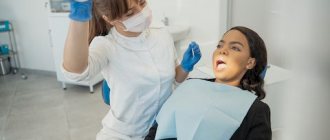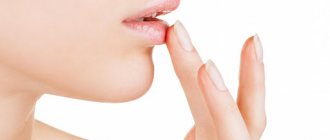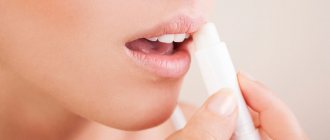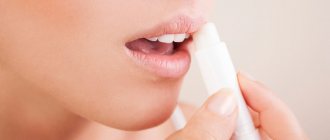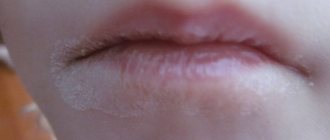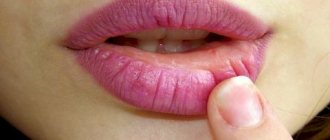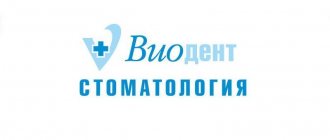Dermatovenerologist
Khasanova
Alina Rashidovna
9 years experience
Make an appointment
Patients often consult a doctor complaining of inflammation in the red border or mucous membrane of the lips. In most cases, a specialist diagnoses “cheilitis”. This is the name for tissue inflammation, which manifests itself in the form of redness, peeling, the appearance of purulent crusts and weeping ulcers. Any attempt to open the mouth when eating or communicating causes sharp pain associated with tissue damage. Without proper treatment, the disease persists for a long time, causing the patient a lot of physical and aesthetic inconvenience. For young people, the prognosis after clinical treatment of cheilitis is completely favorable, but older patients may encounter its complications in the form of leukoplakia and the onset of the oncological process.
Reasons for development
In the clinical practice of most specialists, there are cases where cheilitis on the lips developed on its own or was a side effect of a serious disease of the internal organs or damage to the mucous membrane. Among the most likely causes of the development of the disease are:
- inflammation of the mucous membrane with dermatoses, erythematoses or lichen planus;
- infectious diseases: syphilis, tuberculosis, etc.;
- psoriasis and other skin problems.
Among the unfavorable external factors, it is worth noting an excessive amount of ultraviolet radiation, strong wind, flows of cold or hot air from climate control equipment or ventilation in industrial premises. Signs of cheilitis are often observed in people who work in open areas in direct sunlight.
A separate group includes manifestations of allergic cheilitis, which developed after contact of the lip mucosa with aggressive chemicals or prolonged exposure to ultraviolet radiation. Sometimes doctors observe the clinical picture of secondary cheilitis, when the development of the disease is caused by eczema, neuritis of the facial nerve, pathologies of the muscles and tissues of the facial part of the skull.
GLANDULAR CHEILITIS OF THE LIP
Glandular cheilitis
– a disease of the lips, which is characterized by the close location of the small salivary glands to the red border area and their increased functioning.
People usually get sick after 30 years of age.
The lower lip is affected twice as often as the upper lip.
Injuries and impaired elasticity of lip tissue contribute to the disease.
At the onset of the disease, patients experience slight dryness of the lips and peeling.
As the disease progresses due to erosions and cracks, the pain intensifies, red dots appear on the mucous membrane of the lip - the end sections of the excretory ducts of the salivary glands. Drops of saliva are released from the points in the form of dew, due to the evaporation of which constant dryness develops. Sometimes an infection can occur, even leading to the formation of abscesses.
There are two forms of glandular cheilitis:
primary
secondary.
Primary is not associated with other lip diseases.
Provoking factors for primary glandular cheilitis include tartar, periodontal disease, dental caries, etc. These diseases can lead to infection of the salivary gland ducts.
Secondary glandular cheilitis develops against the background of various diseases in individuals without congenital anomalies of the minor salivary glands.
This form of the disease includes: lichen planus, leukoplakia, lupus erythematosus, etc.
The course of the disease is long.
Treatment
Treatment of glandular cheilitis is surgical: removal or cauterization of each salivary gland in various ways.
Cauterization using a surgical laser is successful.
Anti-inflammatory ointments are used locally: tetracycline, erythromycin, as well as flucinar and sinalar ointments, oxalic ointment, etc.
Treatment of secondary glandular cheilitis involves timely and correct treatment of the underlying disease that was its cause.
Prevention
In order to prevent glandular cheilitis, it is necessary to regularly sanitize the oral cavity, eliminate dry lips, and treat dental caries in a timely manner.
(495) 50-253-50 – free consultation on clinics and specialists
SUBMIT AN APPLICATION FOR TREATMENT
- Dentistry in Germany – Musenhof Clinic
- Dentistry in Israel
- Dental implantation and prosthetics in Hungary
- Therapy – dental treatment
- The structure of the human tooth
- Teeth – milk and permanent
- Caries
- Carious defect - prevention
- Carious defect - treatment
- Caries - preparation techniques
- Seals
- Cement fillings
- Amalgam fillings
- Seal – light
- Glass ionomer cement and composites
- Root canals - treatment
- Stomatitis - symptoms, treatment
- Periodontitis - treatment
- Pulpitis - causes, treatment, prevention
- Tooth pulpitis – initial
- Tooth pulpitis – acute
- Tooth pulpitis – chronic
- Tooth pulpitis – purulent
- Tooth pulpitis – chronic hyperplastic
- Depulpation
- Tooth crown – trepanation
- Gum retraction procedure
- Anesthesia in dentistry
- Anesthesia – application
- Anesthesia – infiltration
- Anesthesia – conduction
- Insulating gaskets for filling
- Therapeutic pads for filling
- Surgery – operating dentistry
- Dental cyst
- Treatment of dental cyst
- Pericoronitis of teeth
- Lip frenuloplasty
- Reasons for tooth extraction
- Tooth – removal
- Wisdom tooth – removal
- Resection of the apex of the tooth root
- Replantation – tooth transplant
- Gum diseases
- Gingivitis – inflammation of the gums
- Gingivitis - acute form
- Gingivitis - chronic form
- Gingivitis - ulcerative form
- Gingivitis – hyperplastic form
- Periodontitis - symptoms, treatment
- Periodontal disease - causes of inflammation
- Flap surgery – gum surgery
- Widmann-Neumann operation
- Operation Ramfjord
- Lateral displacement of the flap
- Coronally advanced flap technique
- Curettage of gum pockets
- Dental splints – splinting
- Vestibuloplasty - methods of implementation
- Vestibuloplasty method - according to Edlan-Meicher
- Vestibuloplasty – according to Clark
- Vestibuloplasty – tunnel
- Operation frenuloplasty
- Osteoplasty – surgical technique
- Gum plastic surgery – gingivoplasty
- Compactosteotomy – surgery of the alveolar process
- Gingivotomy operation
- Gingivectomy operation
- Inflammation of the gums - abscess
- Oral stomatitis – gonorrheal
- Cheilitis on the lips
- Cheilitis - treatment
- Exfoliative cheilitis of the lips
- Meteorological cheilitis of the lips
- Contact allergic cheilitis of the lips
- Lips – chronic crack
- Eczematous cheilitis of the lips
- Atopic cheilitis of the lips
- Glandular cheilitis of the lips
- Hypovitaminous cheilitis of the lips
- Hyapocylar cheilitis of the lips
- Macrocheilitis - causes, treatment
- Macrocheilitis – Miescher syndrome
- Diseases of the human tongue
- Glossitis – groups
- Desquamative glossitis of the tongue
- Black fuzzy tongue
- Diamond-shaped glossitis of the tongue
- Folds on the tongue
- Neuroses of the tongue
- Glossodynia – causes, treatment
- Pemphigus - treatment
- Pemphigus vulgare
- Hyperplastic candidiasis
- Atrophic candidiasis
- Pseudomembranous candidiasis
- Atrophic candidiasis - acute stage
- Actinomycosis - forms, treatment
- Leukoplakia - types, treatment
- Xerostomia - treatment
- Orthodontic treatment
- Malocclusion - causes
- Malocclusion - stages of correction
- Malocclusion - correction in children
- Malocclusion - correction in adults
- Deep bite - treatment
- Types of bracket systems
- Metal bracket system
- Ceramic bracket system
- Sapphire bracket system
- Self-ligating braces
- Bracket system – DAMON Clear
- Lingual braces
- Bracket system – Clarity SL
- Lingual braces systems Incognito
- Removable braces
- Colored braces
- Bracket system – Ormco
- Installation of bracket systems
- Care of the bracket system
- Dental aligners – invisalign
- Malocclusion - surgical correction
- Contraindications to treatment with braces
- Orthodontic structures
- Lip bumpers - application
- Devices – quadrohelixes
- Sapphire bracket systems Inspire ICE
- Dental prosthetics
- Prosthetics - indications
- Prosthetics - contraindications
- Prosthetics - methods
- Prosthetics - technologies
- Prosthetics – permanent
- Dental crowns - types
- Metal crowns
- Metal-ceramic crowns
- All-ceramic crowns
- Plastic crowns
- Zirconium dioxide crowns
- Gold-ceramic crowns
- Dental bridge
- Adhesive prosthesis – no grinding of adjacent teeth
- Methods for installing dental bridges
- Dental bridge – without crown support
- Clasp prosthetics
- Types of clasp prosthetics
- Prosthetics – removable
- Acrylic dentures
- Polyurethane dentures
- Quattro Ti prostheses
- Relining of removable dentures
- Dental inlays - types
- Prosthetics – preparing a tooth for a crown
- Restoring a tooth stump - methods
- Prosthetics – pain relief
- Dentures - care
- Dental implantation
- Dental implantation - history of development
- Indications for dental implantation
- Contraindications to dental implantation
- Dental implantation methods
- Types of Dental Implants
- Types of Dental Implants
- Root-shaped dental implants
- Endodontically stabilized implants
- Plate implants
- Combined implants
- Subperiosteal implants
- Intramucosal inserts
- Jaw bone augmentation
- Tests before dental implantation
- Stages of dental implantation
- Dental implantation – preparation
- Implant installation
- Abutment
- Dental implantation – healing
- Dental implantation - installation of a prosthesis
- Dental implantation – one-step
- Before dental implantation – radiography
- Sinus lift
- Sinus lift – balloon method
- Guided bone tissue regeneration - technique
- Bone tissue – autotransplantation
- Dental implantation – basal
- Dental implantation – transgingival
- Dental implants – mini implants
- Dental implantation – laser
- Dental implantation – 3D
- Dental implants – implant systems
- Dental implants – Astra Tech
- Dental implants – Alpha BIO
- Dental implants – MIS
- Dental implants – NIKO (LIKo)
- Dental implants – Bicon
- Dental implants – Nobel Biocare
- Dental implants – Implantium
- Dental implants – Gimlet system “RADIX”
- Dental implants – Biohorizons
- Dental implants – service life
- Dental implants - care
- Dental implantation - complications
- Dental implantation - complications during surgery
- Dental implantation – complications of the second stage of surgery
- Dental implantation – penetration
- Dental implantation – damage to the mandibular nerve
- Dental implantation – early postoperative complications
- Dental implantation – late postoperative complications
- Aesthetic dentistry - directions
- Air flow teeth cleaning
- Veneers - types
- Veneers – composite
- Veneers – ceramic
- European methods of dental implantation in Moscow
- Dental treatment in South Korea
- Dental treatment in Spain
- Dental treatment in Kassel
- Dental treatment in Frankfurt
- Dental implantation – a complex method
- Dentistry in Moscow
- Treatment of caries in Germany
- Dentistry at the medical center named after. Souraski
April 20, 2014 Maxim
This disease develops as a result of hyperplasia, hyperfunction and often heterotypy of the salivary glands in the area of the red border of the lips and the transitional fold. There are primary and secondary simple glandular cheilitis .
Symptoms and signs depending on the type of cheilitis
The accepted classification of cheilitis makes it possible to clearly establish the type and causes of the disease, as well as to identify the characteristic signs of the pathological process:
- Exfoliative cheilitis is localized on the red border of the lips. It has a clear gender link: it occurs more often in women. The main symptom is peeling of the lips due to neurological disorders: stress, depression, anxiety. Often the inflammatory process develops against the background of hyperthyroidism, or intense activity of the thyroid gland. The danger of exfoliative cheilitis is its ability to be inherited as a genetically fixed change in the body’s immune system.
A feature of exfoliative cheilitis is localization only on the red border of the lips, while the mucous membrane and skin around the mouth remain intact. In most cases, only part of the border is affected, while areas at the corners of the mouth usually retain their appearance. If a patient has dry skin, he often complains of tightness of the lips, the appearance of scales, and a burning sensation. It is almost impossible to completely cure exfoliative cheilitis. The disease proceeds along a sinusoid, sometimes exacerbating, sometimes disappearing under the influence of medications and external factors. Without medical supervision and if you refuse to take a course of treatment, large bleeding crusts form on the lips, which cause discomfort during conversation and eating.
- Glandular cheilitis develops against the background of pathological proliferation of the salivary glands. A humid environment creates favorable conditions for pathogenic microorganisms, as a result of which the mucous membrane becomes easily infected. If the pathology of the salivary glands is congenital, the probability of developing glandular cheilitis is 100%. The risk group also includes patients with dental problems: untreated caries, periodontitis, tartar, etc.
In some cases, glandular cheilitis develops as a result of damage from waste products and the breakdown of pathogenic microorganisms. The disease is more often diagnosed in patients over 30 years of age and is localized on the lower lip. Primary symptoms are dry lips and the appearance of painful cracks. Usually these symptoms are ignored, and attempts are made to combat them with local cosmetic products. Without treatment, the problem worsens: erosions and bleeding wounds appear at the site of cracks. Involuntary licking of dry lips aggravates the pathological process, which leads to their further dryness.
- Contact allergic cheilitis is caused by exposure to an external allergen. This could be the chemical composition of lipstick, microorganisms on the surface of pencils or pens, which the patient is accustomed to often holding in his teeth during work or creative activities. Cheilitis is considered an occupational disease among musicians who are forced to hold the mouthpieces of instruments in their mouths for a long time. The symptoms of this type of pathology are quite common. Patients complain of itching, swelling, burning and inflammation of the lips. After prolonged contact with the allergen, blisters appear on the skin, the rupture of which opens small ulcers and erosions. In the chronic stage, the disease makes itself felt only with minor itching and peeling.
- Meteorological or actinic cheilitis is a reaction to weather conditions. For a sensitive organism, radiation, wind, cold or solar radiation are equally dangerous, provoking the appearance of characteristic symptoms: burning and itching, large crusts and erosion of the mucous membrane. With prolonged exposure to unfavorable climatic factors, the formation of small bubbles with liquid contents is possible. The dry form of cheilitis is considered the most dangerous for patients. Its first symptoms in the form of itching and burning are harmless. However, with prolonged development and lack of treatment, malignancy is possible - the degeneration of affected cells into a malignant formation.
- Atopic cheilitis is a type of skin disease: atopic dermatitis and neurodermatitis. The disease develops against the background of an allergic predisposition of the body, which reacts to cosmetics, perfumes, food and exposure to pathogenic bacteria. In addition to the usual symptoms, there is dryness and damage to the skin in the corners of the mouth, and intense peeling of the face.
- Hypovitaminous cheilitis develops against the background of a lack of B vitamins in the body. Patients usually complain of dryness and burning of the tongue and lips. Vertical cracks and small peeling scales are visible on the skin. The tongue increases in size, and teeth marks become visible on it.
Are you experiencing symptoms of cheilitis?
Only a doctor can accurately diagnose the disease. Don't delay your consultation - call
How is glandular cheilitis treated?
Treatment of simple glandular cheilitis is necessary for complaints of continuous salivation, as well as for inflammatory phenomena of the mucous membrane and red border of the lips.
The most reliable method of treatment is electrocoagulation of the salivary glands through a hair electrode in the gland duct. This treatment method is possible with a small number of hypertrophied glands. In case of multiple lesions, cryodestruction or surgical excision of almost the entire Klein zone is possible.
For secondary glandular cheilitis, the underlying disease is treated.
MedTravel Treatment abroad » Dentistry » Glandular cheilitis of the lips
Treatment of various types of cheilitis
The course is developed taking into account the type of diagnosed disease and the general condition of the body.
- For exfoliative cheilitis, additional consultations with a neurologist and neuropsychiatrist are recommended. The patient is prescribed a course of sedatives. Effective methods of local treatment include laser therapy, ultrasound or radiation therapy, and the use of moisturizing cosmetic creams and ointments. According to indications, hormonal medications and vitamin complexes are prescribed.
- Glandular cheilitis is removed with anti-inflammatory ointments. Local treatment consists of cauterization or desquamation of enlarged salivary glands, and during the rehabilitation period, the use of drugs to eliminate dryness or excess moisture of the mucous membrane.
- When treating atopic cheilitis, the goal is to eliminate any irritating factors. The local course is based on the use of anti-inflammatory and anti-allergic drugs in the form of external ointments. Patients are also recommended to have a hypoallergenic diet that excludes the consumption of fish, citrus fruits, spicy foods and alcohol.
- For meteorological cheilitis, treatment tactics include taking vitamin preparations, using local healing agents and ointments with a high UV filter.
Timely initiation of treatment and the patient completing its full course guarantees relief from the unpleasant symptoms of cheilitis with a long-term effect.
4.Treatment
It should be noted that the first step in the treatment of Manganotti cheilitis is sanitation of the oral cavity and the maximum possible elimination of the risk factors described above (in particular, it is necessary to treat existing foci of infection, comorbid dermatological diseases, according to indications, perform bite correction, prosthetics or adjustment of dentures, etc. .P.).
Manganotti cheilitis itself does not pose a threat to life and health, so treatment is carried out as planned and can take 1-2 months. Local drugs are used, primarily healing and anti-inflammatory (solcoseryl, methyluracil; sometimes, in the presence of inflammation, hormone-containing drugs are indicated). Oil preparations of vitamins A and E are effective. However, the high cancer risk is always taken into account.
If the lip cannot be completely healed or frequent relapses are observed, the method of choice is radical surgical removal of the eroded area. In a “calm” situation, preoperative drug preparation is carried out for several weeks, but if atypical cells are detected in laboratory tests, the operation is performed urgently.
If all the measures described above are taken in a timely manner and treatment (including surgery) was carried out before the onset of intensive growth of the malignant tumor, the prognosis is almost always favorable.
